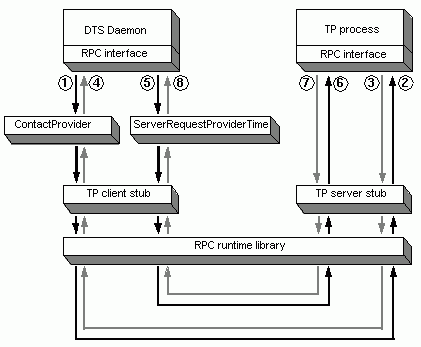
When you use a time-provider with a system running DTS, the external time-provider is implemented as an independent process that communicates with a DTS server process through remote procedure calls (RPCs). A remote procedure call is a synchronous request and response remote procedure call" between a main calling program and a procedure executing in another process. RPC applications are based on the client/server model. In this context, the following processes act as the client and server components in the RPC-based application:
· The DTS daemon is the client.
· The Time-Provider process (TP process) is the server.
Both the RPC-client (DTS daemon) and the server (TP process) must be running on the same system.
Applications running on RPC communicate through an interface that is well known to both the client and the server. The RPC interface consists of a set of procedures, data types, and constants that describe how a client can invoke a routine running on the server. The server offers the interface to the clients through the Interface Definition Language (IDL) file.
The IDL file defines the syntax for an operation, including the following:
· The name of the operation
· The data type of the value that the operation returns (if any)
· The order and data types of the operation's parameters (if any)
The TP process offers two procedures that DTS calls to obtain time values. These procedures are ContactProvider and ServerRequestProviderTime.
At each system synchronization, DTS makes the initial remote procedure call (ContactProvider) to a TP process that is assumed to be running on the same node.
If the TP process is active, the RPC call returns the following arguments:
· A successful communication status message
· A control message that DTS uses for further processing
If the TP process is not active, the RPC call either returns a communication status failure or a time-out occurs. DTS then synchronizes with other servers instead of with the external time-provider.
If the initial call (ContactProvider) is successful, DTS makes a second call (ServerRequestProviderTime) to retrieve the timestamps from the external time-provider. The control message sent by the TP process in the first RPC call specifies the length of time DTS waits for the RPC call to complete. The TP process returns the following parameters in the procedure call:
· A communication status message.
· A time structure that contains timestamps collected from the external time-provider. (DTS then uses these timestamps to complete its synchronization.)
The following figure illustrates the RPC calling sequence between DTS and the TP process. Note that solid black lines represent the path followed by input parameters; dashed lines represent the path followed by output parameters and return values.
The following steps describe the process shown in the following figure:
DTS/Time-Provider RPC Calling Sequence

1. At synchronization time, DTS calls the ContactProvider remote procedure. Input parameters are passed to the TP client stub, dispatched to the RPC runtime library, and then passed to the TP server stub.
2. The TP process receives the call and executes the ContactProvider procedure.
3. The procedure terminates and returns the results through the TP server stub, the RPC runtime library, and the TP client stub.
4. The procedure terminates in the DTS call, where the returned parameters are examined.
5. DTS then calls the ServerRequestProviderTime remote procedure. Input parameters are passed to the TP client stub, dispatched to the RPC runtime library, and then passed to the TP server stub.
6. The TP process receives the call and executes the ServerRequestProviderTime procedure.
7. The procedure terminates and returns the results through the TP server stub, the RPC runtime library, and the TP client stub.
8. The DTS remote procedure call terminates and the timestamps are returned as an output parameter. DTS then synchronizes using the timestamps returned by the external time-provider.
The following topic describes the remote procedures that are exported by the TP process during the previous sequence.
More:
ServerRequestProviderTime Procedure